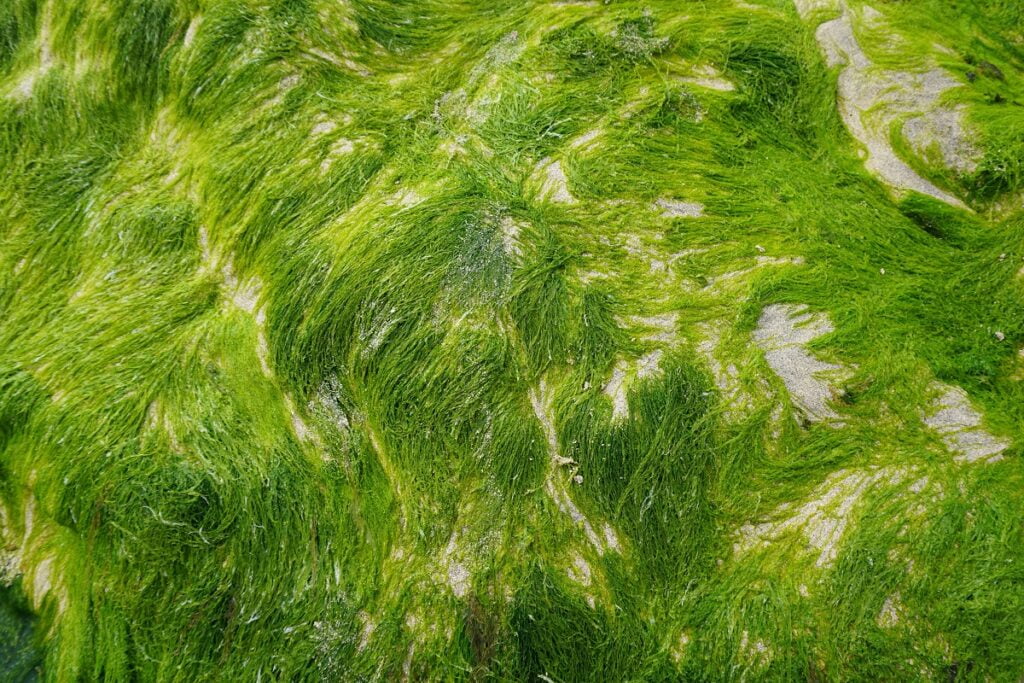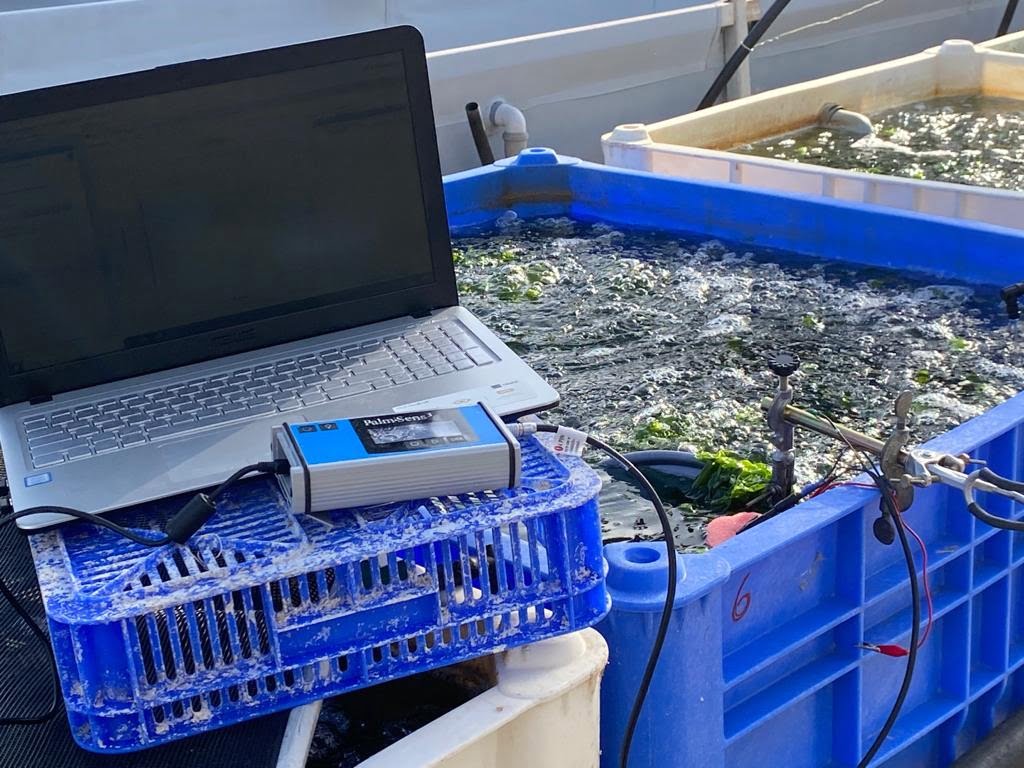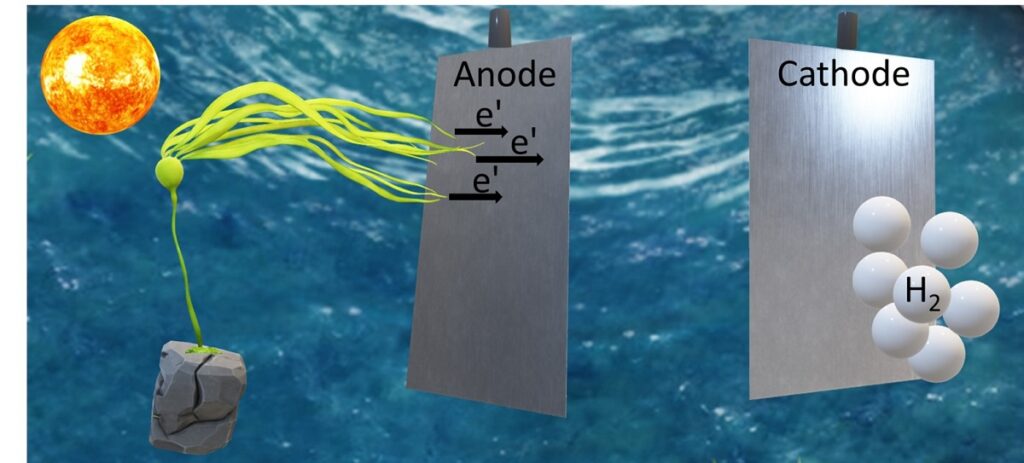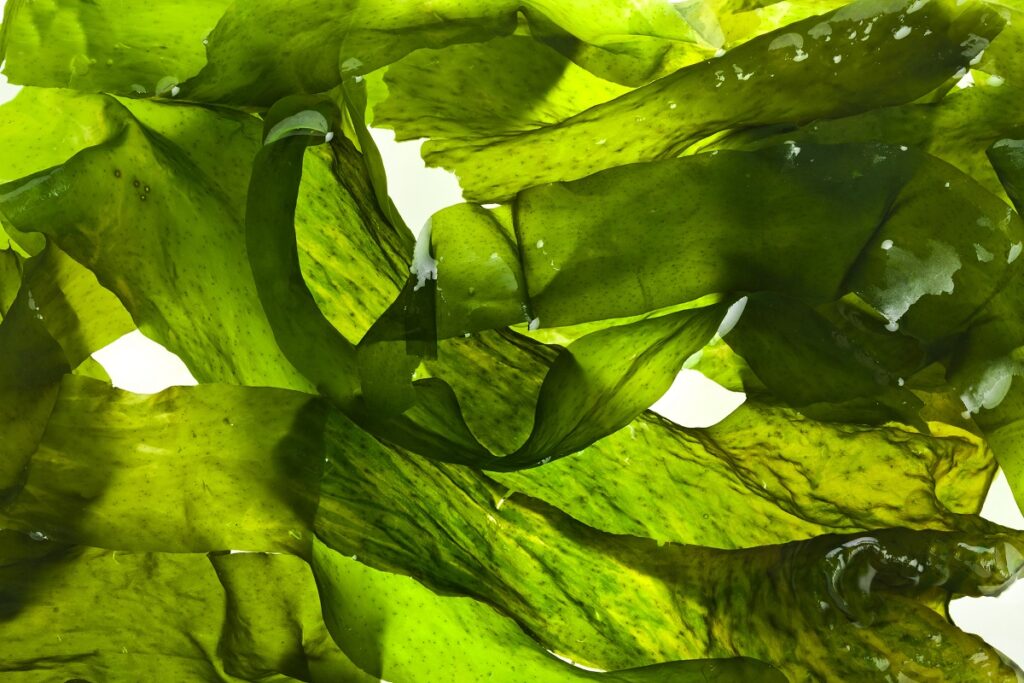A trip to the beach by doctoral student Yaniv Shlosberg from the Schulich Faculty of Chemistry of Technion – Israel Institute of Technology has resulted in a new way to harvest electricity from seaweed.
“So actually, this whole thing started for fun,” Shlosberg tells NoCamels in a video conference interview. “I was studying electricity production from cyanobacterial cells in the lab. One weekend, I went to Habonim beach and when I was in the water swimming, I saw there was a kind of seaweed called Gracilaria. Now this seaweed looks like red wires. And in the lab, I also had actual red electricity wires. In my imagination, they looked the same. Perhaps I had worked too much, I don’t know, but it reminded me of it.”
You could say that Shlosberg got a feeling of what jumping out of the bathtub screaming “Eureka” must have meant to Greek inventor Archimedes.

The connection struck a chord and he cut short his relaxation day. “I went Archimedes style. I put some algae in a bag and actually ran to the lab,” he says.
Toying with the seaweed on the current producing electrodes of his lab he got an impressive reaction. “It was like ‘Wow!’ I saw a very, very big amount of current production. I was excited,” says Shlosberg.
Together with a consortium of researchers from three Technion-Israel Institute of Technology faculties, members of the Grand Technion Energy Program (GTEP), where Shlosberg is also a member, and with a researcher from the Israel Oceanographic and Limnological Research Institute (IOLR), the team recently published a study on using living organism as the source of electrical currents in bio-photoelectrochemical cells in the journal Biosensors and Bioelectronics. Co-authors that can be cited include Prof. Noam Adir and Prof. Gadi Schuster, Prof. Omer Yehezkeli, and Prof. Alvaro Israel from the IOLR.
Breaking with old patterns or the ‘revolution of the seaweeds’
Some microorganisms like bacteria possess electricity-producing properties. Their energy is harvested through microbial fuel cells. A tank is filled with water containing the bacteria. The bacteria attach themselves to an electrode called anode and pass on their electrons to an opposite electrode called cathode. The transfer of electrons produces electricity.
This process has been known for years but met significant problems. To produce sufficient electricity many bacteria need to be cultivated in a tank. This in turn raises concerns of pollution and poses a health hazard since bacteria can be pathogenic, says Shlosberg.
Another known approach consists in using photosynthetic organisms. The electrons they release when doing photosynthesis are harvested through bio-photoelectrochemical cells. In essence, harvesting this energy works much like in microbial fuel cells. “The principle is the same: you attach the organism to an electrode,” says Shlosberg.

While the mechanisms of harvesting electricity from living organisms is not novel, the source, namely seaweeds, is. “There were many works studying [the use of bio-photoelectrochemical cells], we are not the first ones. But all works were done only with microorganisms such as cyanobacteria or microalgae, that is, unicellular algae. And the problem was that they did not really produce a big amount of electrical current. There are a lot of publications, and it was pretty, and they were published in very good journals, but it remained a concept,” says Shlosberg.
“And here lies the revolution of the seaweeds, because seaweeds produce a very high amount of current, something like thousands or more times than cyanobacteria. And we almost reached the amount of current [produced by] solar cells,” he says.
“It’s amazing how we as scientists should be in front of science and do novel things. [But instead], we are always stuck in patterns. Like in this case. Well…you can say about every invention ‘Why didn’t anyone try it before?’ Later when I thought this backwards, I said, ‘How could it be that no one had tried other photosynthetic organisms?’ Because if I go to someone who is not a scientist and [mention] the word photosynthesis, [and] ask him what is the organism that you imagine, he will say ‘A plant!’. But no one has ever tried it for decades,” says Shlosberg.
“It’s so amazing how we scientists don’t dare try things that are new until something like this happens…the apple falling on our head,” he says.
Ul-What!?
Amongst the seaweeds tested by Shlosberg and cohorts for their energy-producing properties, one stood out: Ulva also known as sea lettuce. “I tried about six kinds of seaweeds with different textures and different pigments. Ulva was the best and we ascribe it to the photosynthetic rate which we know to be really high. I think it’s one of the best organisms in the manner of photosynthetic production,” says Shlosberg, who when not at the beach or in the lab can be found practicing capoeira, kickboxing, and aerobic sports.
Ulva is a widespread type of seaweed, found throughout the Mediterranean and even in colder Northern waters. It is very easy to cultivate, does not require a lot of attention and its rate of photosynthesis causes it to grow very fast. “At the IORL [Israel Oceanographic and Limnological Research Institute], they have big Jacuzzi pools on the seashore. And what they do is they just stream water inside and outside from the sea. And this simple process is enough to grow Ulva,” says Shlosberg.
Sign up for our free weekly newsletter
SubscribeThe use of Ulva goes well beyond the field of energy production. The plant has also been used to produce fish food and cosmetics. “I have a friend […], he discovered that the Ulva has some anticancer components that you can extract. So it’s marvelous this Ulva,” says Shlosberg.
Electron shuttles
Cyanobacteria and smaller photosynthetic microorganisms rely on sunlight to produce energy, just like Ulva. But unlike Ulva, their energy output drops in the dark, while Ulva’s persists. “We don’t really know the mechanism,” says Shlosberg, “but we do know that in the dark it secretes some molecules outside that can transport the electrons [to the electrodes].”
One of these molecules is called NADPH which works like an “electron shuttle”, says Shlosberg. In fact, the research team found that some photosynthetic organisms like Ulva secreted electrons as an end product of their photosynthesis.
“And this was a big surprise,” says Shlosberg, “because photosynthetic organisms don’t want to get rid of electrons.” This is because electrons, garnered from the splitting of a water molecule following the absorption of light, drive the photosynthetic processes of the organism, including the production of sugar which the organism uses for its own consumption.
Why would an organism then abandon something so vital to its survival? “We don’t know,” says Shlosberg, “but the important thing to understand is that it’s not like the organism is releasing big amounts of it. Only a small amount of [NADPH transported electrons] can get out. So it could just be leaks, something not by intention.”
Did you just say ‘cheap seawater’?
Like many other photosynthetic organisms, Ulva absorbs carbon dioxide. “We are not only producing the electrical current, we are also reducing the carbon in the atmosphere, which is a big ecological benefit because the world is very concerned about global warming,” says Shlosberg.
Such concerns are reflected in the booming climate and energy industry. Last year alone $2.2 billion was raised in investments by Israeli climate tech companies.

Alongside being ecological, expanding the use of Ulva for electricity production is also cost-effective. “First, one big advantage is that it’s very easy to make, the process is very simple, and practically you don’t need to do almost anything. It would be something local. You put your system in the sea or in artificial cultivation tanks and it goes by itself. So you don’t have many manufacturing and transportation costs,” says Shlosberg.
For the soft-hearted, mass exploitation of tanks filled with seaweed does not harm the plant itself. “When you use seaweed, you don’t really hurt the seaweed when you produce electricity, because you only use a small amount of their electrons for the electricity. And [the seaweeds] stay alive and they grow,” says Shlosberg.
Finally, using the sea as a base for energy production has a significant advantage over land. “Much of the seawater is not exploited,” says Shlosberg. “[On land] when you want to establish your technology you need the area and then you compete with real estate, or with farming. But the seawater is cheap.”
The future lies in seaweed
Shlosberg felt optimistic when asked about the future market potential of using bio-photoelectrochemical cells with seaweed for electricity production. “I do believe that this invention has a big potential to succeed. I think it will be one of the major [green energy] technologies, and together with the others it can perhaps clean the world. And we’re working hard to promote it from a basic concept into an applicative solution,” he says.
With more than 165.000 registered algae species lying around the oceans, according to the AlgaeBase, odds are big in stumbling upon other high energy-yielding seaweeds. The supply seems limitless.
“I get a lot of calls and text messages from big people, like CEOs of companies, and I’m very complimented because I’m just a PhD student. I’m very happy to see how much interest this thing attracts. And when people in high positions are interested to invest money and to cooperate and collaborate [with] me it gives me the feeling that I am right, that there is a big potential to really make a difference around the world with this method,” says Shlosberg.
Related posts

Resilient And Nutritious New Plant-Based Milk Aims To Make A Splash

Chocolate From Cultivated Cocoa Comes Without Environmental Toll

Plastic Fantastic: Startup Takes PVC Back To Its Crude Oil Roots




Facebook comments